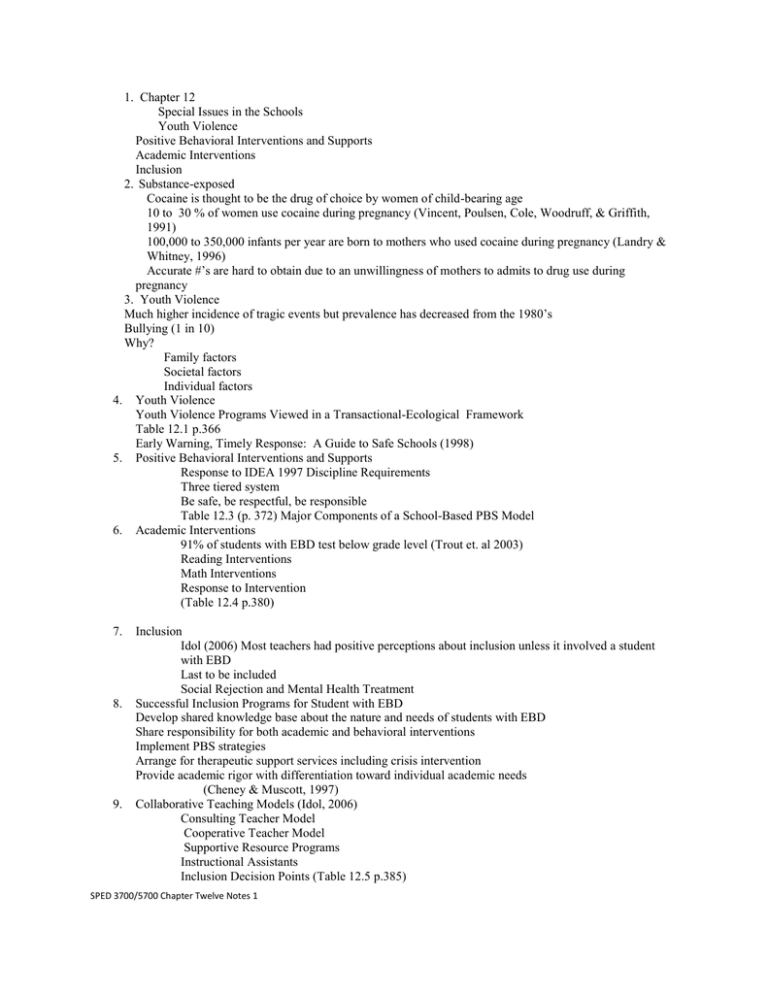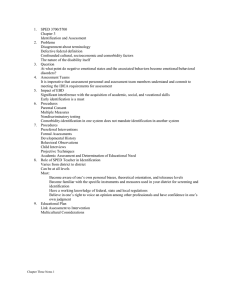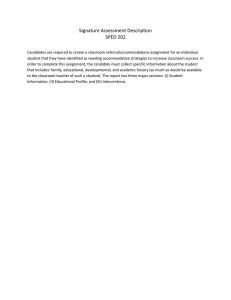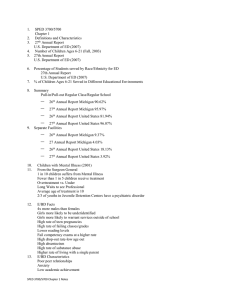
1. Chapter 12
Special Issues in the Schools
Youth Violence
Positive Behavioral Interventions and Supports
Academic Interventions
Inclusion
2. Substance-exposed
Cocaine is thought to be the drug of choice by women of child-bearing age
10 to 30 % of women use cocaine during pregnancy (Vincent, Poulsen, Cole, Woodruff, & Griffith,
1991)
100,000 to 350,000 infants per year are born to mothers who used cocaine during pregnancy (Landry &
Whitney, 1996)
Accurate #’s are hard to obtain due to an unwillingness of mothers to admits to drug use during
pregnancy
3. Youth Violence
Much higher incidence of tragic events but prevalence has decreased from the 1980’s
Bullying (1 in 10)
Why?
Family factors
Societal factors
Individual factors
4. Youth Violence
Youth Violence Programs Viewed in a Transactional-Ecological Framework
Table 12.1 p.366
Early Warning, Timely Response: A Guide to Safe Schools (1998)
5. Positive Behavioral Interventions and Supports
Response to IDEA 1997 Discipline Requirements
Three tiered system
Be safe, be respectful, be responsible
Table 12.3 (p. 372) Major Components of a School-Based PBS Model
6. Academic Interventions
91% of students with EBD test below grade level (Trout et. al 2003)
Reading Interventions
Math Interventions
Response to Intervention
(Table 12.4 p.380)
7.
8.
9.
Inclusion
Idol (2006) Most teachers had positive perceptions about inclusion unless it involved a student
with EBD
Last to be included
Social Rejection and Mental Health Treatment
Successful Inclusion Programs for Student with EBD
Develop shared knowledge base about the nature and needs of students with EBD
Share responsibility for both academic and behavioral interventions
Implement PBS strategies
Arrange for therapeutic support services including crisis intervention
Provide academic rigor with differentiation toward individual academic needs
(Cheney & Muscott, 1997)
Collaborative Teaching Models (Idol, 2006)
Consulting Teacher Model
Cooperative Teacher Model
Supportive Resource Programs
Instructional Assistants
Inclusion Decision Points (Table 12.5 p.385)
SPED 3700/5700 Chapter Twelve Notes 1
10. Caring for Students with EBD Amidst Educational Reform
ADVOCATE
11. Advocating for Students with E/BD
Protecting student rights
Individuality
Increase special education’s empirical base
Question ineffective practices
Prepare students to succeed in general education
Protect student with E/BD in general ed settings
Commit to professional growth
Promote ownership
Ensure mental health services
12. Prenatal and Perinatal Outcomes
Maternal Life Style Problems
60-70% of cocaine-abusing pregnant women receive no prenatal care
Increase risk for infectious diseases and vitamin deficiencies
13. FAS
Fetal Alcohol Syndrome
Alcohol leading cause of MR in the U.S. (Davis, 1994)
FAS dx
SMALL HEAD SIZE, FLAT MIDFACE AND NASAL BRIDGE AND PROTRUDING
FOREHEAD
GROWTH DEFICIENCY
CENTRAL NERVOUS SYSTEM DAMAGE
FAE is dx when two of the three criteria are present
14. Newborns, Infants, and Toddlers
Neurobehavioral Characteristics
Irritability
Easily agitated and difficult to console
Startle easily
Hypersensitive to certain stimuli such as sounds and lights
15. Substance –exposed Young Children
Biology +Environment = Interactions measurement
Irritable
Hypersensitive to stimuli
Unable to process multiple stimulation
16. Intervention
There is no typical profile of substance-exposed children
Therefore, no typical interventions
IFSP
Impact on Teachers
Application of what is already known about early intervention
17. Sexual Abuse and E/BD
E/BD 74% of females and 21% of males (Miller, 1993)
General 20% female, 1% male (Miller, 1993)
Defined: fondling, sodomy, oral stimulation, involving the child in masturbation, sexual intercourse of
penetration with an object, and other forms of sexual molestation
18. Sexual Abuse
Sexual Exploitation
Inappropriate Sexual Behavior
Over 200,000 cases of child sexual abuse are reported each year (HHS, 1999)
19. Abusers and Abused
SPED 3700/5700 Chapter Twelve Notes 2
75% to 80% of sexual abuse cases occur by someone the child knows (Finkelnor, 1979)
7% by strangers (Tsai et al, 1979)
Perpetrators are generally males (Berk, 2000)
Age Range 8 to 13 (Waterman &Lusk, 1986)
SES does not appear to be a factor
20. Effects
Affective
Guilt, shame, anxiety, depression
Psychosomatic Symptoms
Cognitive/School-related effects
Concentration, helpless victim
21. Behavioral effects
Acting out, antisocial
22. Treatment
Individualized
Systems therapy
23. Implications for Teachers
Abrupt changes in behavior such as: loss of appetite, sleep disturbances, failing schoolwork
Inappropriate seductive behavior with class mates, teachers, and other adults
Knowledge of or unusual interest in sexual matters inappropriate to child’s age and developmental level
Promiscuity
Anger directed anywhere and everywhere
Reluctance to be with a certain person
Regressive behavior
Depression, withdrawal, few friends
Extreme passivity and compliance
Repeated running away
SPED 3700/5700 Chapter Twelve Notes 3






